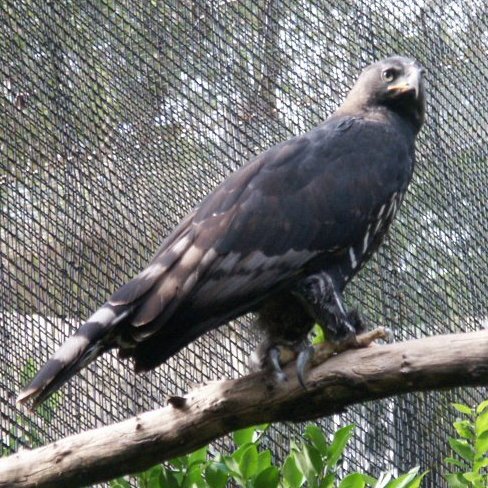| |
|
| Scientific Name: Stephanoaetus coronatus | |
| Geographical
Range: Found only in Mozambique, most
of Zimbabwe and north eastern and along the east coast of South Africa
|
|
| Habitat: Evergreen forests including riverine forests | |
| Diet in
the Wild: The Crowned Eagle is a carnivore
that feeds on mammals 98% of the time. Sometimes the eagle my feed on
a reptile such as Varanus lizards or large snakes, including
venomous species.
The main prey of the Crowned Eagle, whose habitat is in dense forest areas, is the monkey. When they main prey of the Crowned Eagle is scarce the eagle will kill small mammals. ( i.e. rats) |
|
| Conservation Status: protected | |
| Location in the Zoo: Raptor Canyon | |
| |
|
| Physical
Description: Crowned Eagles are very large, weighing about ± 3.8 Kg and about 80-90 cm tall. They are very powerful eagles that have a full divides crest. Their wings are short and rounded while the tail of the crowned eagle is very long and broad. They have a compressed bill. The crowned eagle has heavy legs and heavy, short toes with large talons. |
Social
Organization:: Social Organization of the crowned eagle is family groups. The family groups consist of the mother, father, and one or two children. They remain in the family group until the children are old enough to care for themselves |
| Special
Adaptations: The Crowned Eagle is very seldom seen inside the forest. Most of the time they perch on trees that overlook glades or water-holes. The normally perch in the early morning and evening so they can catch their prey off guard. Much of their time is devoted to soaring over the forest awaiting their prey, which is normally a monkey that is feeding on tree-tops. They hunt by dropping on their prey from a perch. The Crowned Eagle has the advantage of being able to fly silently to and from perches. Most of the Eagles killing is done on the ground, except for the monkey and hyrax. Killing on the ground for the Eagle gives it another advantage, because it has the ability to fly almost vertically to a branch. |
 |
| Reproductive
Behavior:
Both sexes take part in the 49 day incubation period, with the female performing up to 90% of the incubation work. While the female eagle is in incubation period the responsibility of the male is to bring prey to the nest once every three to five days. |
The Animal
at the Zoo: At
the Fort Worth Zoo there were two animals on exhibit in Raptor Canyon. |
 http://safaricamlive.com/Encyclopedia/birds/eagles/Crowned%20Eagle%20Info.htm |
Sequoia Ford 
|

